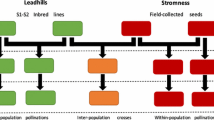Abstract
The Poas have adjusted themselves to contrasting climates from warm temperate to high arctic regions of both the Northern and the Southern Hemispheres. Their bipolar distribution would suggest great geologic age, but they nevertheless have preserved evolutionary youthfulness through polyploidy and apomixis. Transfer of large blocks of heredities between long separated groups of species is accordingly possible without causing disaster to their reproductive mechanism by seed. The Poas have not yet reached the limits of their potential to exchange heredities between species that belong to taxonomically distinct sections, between species of separate continents, and between species of the Northern and the Southern Hemispheres which have remained apart since early geologic periods.
Similar content being viewed by others
References
Åkerberg Erik, 1936. Studien über die Samenbildung bei Poa pratensis L. Botaniska Notiser 1936: 213–280.
Åkerberg Erik, 1939. Apomictic and sexual seed formation in Poa pratensis. Hereditas 25: 359–370.
Åkerberg Erik, 1942. Cytogenetic studies in Poa pratensis and its hybrid with Poa alpina. Here ditas 28: 1–126.
Åkerberg Erik, and Sigrid Bingefors, 1953. Progeny studies in the hybrid Poa pratensis x Poa alpina. Hereditas 39: 125–136.
Åkerberg, Erik, and Axel Nygren, 1959. Poa pratensis, trivalis, palustris, compressa und verwandte Arten. In Handbuch der Pflanzenzüchtung. 2. Aufl. 4: 392–418.
Almgård Gunnar, 1960. Experiments with Poa. I. Studies of Poa longifolia as a fodder grass and as a component in interspecific hybrids. Ann. Roy. Agri. College, Sweden. 26: 77–119.
Clausen, Jens, 1954. Partial apomixis as an equilibrium system in evolution. Proceed. 9th Int. Congr. Genetics, Bellagio, 1953. Caryologia, Supplement to Vol. 6: 469–479.
Clausen, Jens, Paul Grun, Axel Nygren, and Malcolm A. Nobs. 1951. Genetics and evolution of Poa. Carnegie Inst. Wash. Year Book No. 50: 109–111.
Clausen, Jens, and William M. Hiesey, 1958. Experimental studies on the nature of species. IV. Genetic structure of ecological races. Carnegie Inst. Washington, Pub. 615. vii + 312 pp.
Clausen, Jens, William M. Hiesey, and Malcolm A. Nobs, 1954. The Poa program. In Carnegie Inst. Wash. Year Book No. 53: 151–156.
Clausen, Jens, William M. Hiesey, and Malcolm A. Nobs, 1958. Poa investigations. In Carnegie Inst. Wash. Year Book No. 57: 272–278.
Clausen, Jens, William M. Hiesey, and Malcolm A. Nobs, 1959. Evolutionary processes in apomictic species of Poa. Carnegie Inst. Wash. Year Book No. 58: 358–360.
Cox, Lois M., and Jens Clausen, 1955. Chromosome numbers of hybrid Poa lines. In Carnegie Inst. Wash. Year No. 54: 175–177.
Grun Paul, 1954. Cytogenetic studies of Poa. I. Chromosome numbers and morphology of intraspecific hybrids. Am. Jour. Bot. 41: 671–678.
Grun Paul, 1955. II. The pairing of chromosomes in species and interspecific hybrids. Am. Jour. Bot. 42: 11–18.
Hartung, Marguerite, E., 1946. Chromosome numbers in Poa, Agropyron, and Elymus. Am. Jour. Bot. 33: 516–531.
Hiesey, William, M., 1953. Growth and development of species and hybrids of Poa under controlled temperatures. Am. Jour. Bot. 40: 205–221.
Hiesey, William M., 1956. Responses of hybrid bluegrass strains to contrasting environments. Proceed. 7th Int. Grasslands Congr. 1956: 212–221.
Löve Askell, 1952. Preparatory studies for breeding Icelandic Poa irrigata. Hereditas 38: 11–32.
Müntzing Arne, 1933. Apomictic and sexual seed production in Poa. Hereditas 17: 131–154.
Müntzing Arne, 1940. Further studies on apomixis and sexuality in Poa. Hereditas 26: 115–190.
Nannfeldt, J. A., 1937. The chromosome numbers of Poa sect. Ochlopoa A. and Gr. and their taxonomic significance. Botaniska Notiser 1937: 238–254.
Nygren Axel, 1950. Cytological and embryological studies in arctic Poa. Symbolae Bot. Upsaliensis 10: 4: 1–64.
Nygren, Axel, 1951. Embryology of Poa. In Carnegie Inst. Wash. Year Book No. 50: 113–115.
Triplett, Edward L., and Jens Clausen, 1954. Chromosome numbers of hybrid Poa lines. In: Carnegie Inst. Wash. Year Book No. 53: 156–157.
Author information
Authors and Affiliations
Rights and permissions
About this article
Cite this article
Clausen, J. Introgression facilitated by apomixis in polyploid Poas. Euphytica 10, 87–94 (1961). https://doi.org/10.1007/BF00037208
Received:
Issue Date:
DOI: https://doi.org/10.1007/BF00037208




